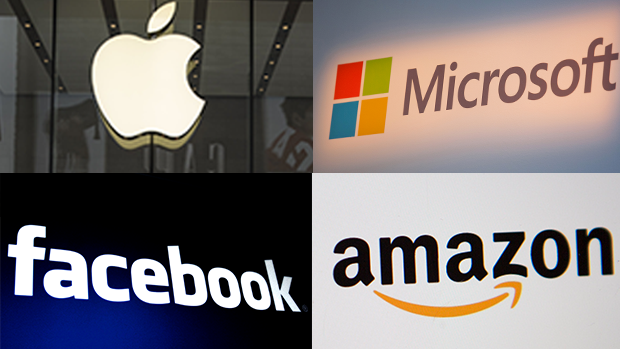Jan 3, 2019
Apple shares plunge after iPhone maker cuts revenue forecast
, Bloomberg News

Apple Inc. plunged to its lowest price in a year-and-a-half after the company cut its revenue outlook for the first time in almost two decades, citing weaker demand in China.
Chief Executive Officer Tim Cook said sales will be about US$84 billion in the quarter ended Dec. 29, down from earlier estimates of US$89 billion to US$93 billion. Apple posted sales of US$88.3 billion in the fiscal first quarter a year earlier, so the new forecast would mean Apple is reporting a holiday quarter slowdown for the first time since Cook became CEO in 2011.
Apple shares fell 10 per cent to US$142.19, the biggest drop in almost six years, in New York Thursday. The revenue revision, which came late Wednesday, led markets lower around the world and also triggered a slump for Asian suppliers and a wave of lower price targets from Wall Street.
The announcement, made in a letter from Cook to investors, comes after weeks of signals from inside Apple and its supply chain indicating the Cupertino, California-based company is struggling to sell the latest iPhones released in September. The flagship product earns Apple about two-thirds of its revenue, and allows the company to generate more money from attached products like Apple Watches, AirPods, and services like Apple Music.
Tim Cook’s Letter to Shareholders About Sales Slowdown: Full Text Read Tim Cook’s Memo to Employees About iPhone Sales Slowdown
“While we anticipated some challenges in key emerging markets, we did not foresee the magnitude of the economic deceleration, particularly in Greater China,” Cook wrote. Greater China, a region that includes the mainland, Hong Kong and Taiwan, accounted for most of the revenue shortfall, but iPhone upgrades also weren’t as strong as the company anticipated in some developed markets, Cook said.
WEIGH IN

Which of these tech names is the best buy right now?
Suppliers in Europe and Asia slumped on the news.
Several key Apple suppliers overseas had cut their revenue estimates during the past few months, suggesting something was amiss. In November, the company said it would stop reporting unit sales of iPhones, iPads and Macs beginning in fiscal 2019. That sparked concern Apple wanted to avoid disclosing weak growth numbers. Apple’s stock had fallen 32 per cent from an October peak to its close of US$157.92 Wednesday amid growing concerns about the iPhone.
In December, Bloomberg News reported the company was facing a “fire drill” to boost iPhone sales. That led Apple to aggressively market the iPhone XR on its website for US$449, about US$300 less than its official sticker price. The deal required customers to trade in an iPhone 7 Plus, a high-end handset from two years earlier.
Still, the market seemed to be caught off guard.
“We were surprised about the magnitude of the miss and the negative impact of China demand for iPhones,” wrote Citigroup Global Markets Inc. analyst Jim Suva.
At least six Wall Street firms, including BTIG and RBC, lowered their share price forecasts by more than 15 per cent after Cook’s letter.
Cook said the new iPhone models were released earlier than the flagship iPhone X last year, which created a difficult year-over-year comparison. The iPhone X launched in November 2017, while the iPhone XS and XS Max were released in September. Cook also noted supply constraints to new models of the Apple Watch, iPad Pro and AirPods.
“IPhone upgrades also were not as strong as we thought they would be,” he said, meaning the sales of new models to current customers replacing their old phones.
The CEO attributed much of the company’s “shortfall” in its outlook to struggles in China that he pinned on the economy and “rising trade tensions” with the U.S.
“As the climate of mounting uncertainty weighed on financial markets, the effects appeared to reach consumers as well, with traffic to our retail stores and our channel partners in China declining as the quarter progressed,” Cook said.
Apple isn’t the only company facing difficulties in a slowing Chinese economy and escalating trade tensions. FedEx Corp., Starbucks Corp., Tiffany & Co. and Daimler AG are also finding it harder to sell their wares in the world’s second-largest economy. There are likely many others, too, that will be forced to announce lower-than-expected earnings, according to the chairman of the White House Council of Economic Advisers.
“It’s not going to be just Apple,” CEA chairman Kevin Hassett said in an interview on CNN. “There are a heck of a lot of U.S. companies that have sales in China that are going to be watching their earnings being downgraded next year until we get a deal with China.”
The timing of Apple’s announcement blaming its shortcomings partly on President Donald Trump’s trade war with China may increase pressure on American officials to ease the tensions quickly. Mid-level officials from the Trump administration are scheduled to travel to Beijing for talks early next week.
While iPhone revenue accounted for the forecast cut, Apple’s other product categories, including the iPad and services, grew a combined 19 per cent year-over-year, he said. Services generated US$10.8 billion in revenue for the quarter -- a 27 per cent increase from a year earlier.
Apple’s decision to cut its sales outlook, “isn’t a huge shock at this point,” said Shannon Cross of Cross Research. “It will be interesting to see how Apple shares react if there’s a China trade agreement.”








